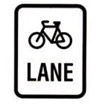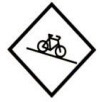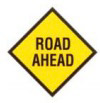Bicycle safety
Cycle Smart, Cycle Safe
Whether you’re riding to UQ for work, study or leisure, the most important part of any trip is safety.
UQ’s Cycle Smart, Cycle Safe campaign aims to raise awareness of bicycle safety and lower the risk of accidents involving cyclists, pedestrians and motorists – on campus and beyond.
Since 2015, the campaign has improved cycling infrastructure on UQ campuses and sites. Each semester the campaign also organises:
- safe cycling workshops
- safety tips and communication.
We encourage you to come along to workshops and events, whether you’re a new student, returning student, or staff member.
To continue improving safety for cyclists, pedestrians and other road users, report all accidents and near misses to Security by phone (07) 3365 1234 or email security@pf.uq.edu.au.
In Queensland, bicycle riders have to follow both the general road rules and specific rules for cyclists.
While these rules are enforced through Queensland law, there are other everyday safety tips you can follow to keep safe while you ride:
Be predictable
Ride in as straight a line as possible. Keep to the left in a lane, but don’t hug the gutter and don’t weave around parked cars or obstacles.
Signal
If you are turning right, signal by extending your right arm sideways from your bicycle. This is a requirement of Queensland law. It’s a good idea to signal left as well.
Be aware
Never text or listen to headphones while riding. Regularly scan the road in front of you and behind you. Watch for cars entering from driveways and side streets. Keep your eyes and ears on the traffic.
Keep left
Keep as far to the left as reasonably possible. For cyclists this means leaving space for unexpected pot holes and car doors! On two-lane roads, you can travel in the right lane when necessary (e.g. to make a right-hand turn).
Shared paths and footpaths
Slow down and sound your bell when you approach pedestrians. When you ride past pedestrians, pass them on the right. These are requirements of Queensland law.
Public footpaths
Cyclists are allowed on public footpaths unless there are signs stating otherwise. Keep left and give way to pedestrians.
Campus footpaths
There are some areas on campus where cyclists have to dismount and walk their bicycle. Look out for signs before riding through any pedestrian areas.
Bicycle lanes and bike paths
You can choose whether or not to use a bicycle lane when one is provided. Never ride in a bicycle lane on the wrong side of the road (i.e. travelling towards oncoming traffic).
Speed
The speed limit on campus roads is 30km per hour, reducing to 15km per hour at pedestrian crossings and speed bumps. Riding at high speeds increases the likelihood of an accident.
Overtaking on the left
You are allowed to overtake other vehicles on the left unless they are signalling and turning left. Be aware! Sometimes drivers forget to indicate.
Roundabouts
While motor vehicles must turn right from the right lane, cyclists can turn right from the left or right lane. If you choose to turn right from the left lane, you also have to give way at each exit to vehicles leaving the roundabout. Wherever possible, we recommend turning right from the right lane, the same way as other vehicles.
Hook turns
Cyclists are allowed to perform hook turns to turn right at an intersection.
Bicycle essentials
Thinking of buying a bike? At a minimum, choose a well-maintained used or new bicycle with a:
- rear reflector
- effective brake
- bell
- front white light, and
- rear red light.
All cyclists in Queensland have to wear a securely fitted approved helmet at all times when riding.
Accessories
There are all kinds of bicycle accessories or clothing that can improve both safety and comfort. Here are some to consider:
- mudguards
- racks and panniers
- mirrors
- bicycle lock
- repair kit and pump
- cycling computer
- high visibility or reflective clothing
- padded shorts
- cycling shoes with stiff soles
- cleats (for high-performance riders)
- gloves to protect your hands from sun, wind, or if you fall.
There are two types of signs you might encounter when you ride: regulatory signs and advisory signs.
Regulatory signs are enforceable by law. You can be fined if you fail to notice, or ignore a regulatory sign.
Advisory signs are designed to communicate information to cyclists. Advisory signs ensure your ride is safe and enjoyable.
Here are some of the signs you might encounter when you ride around campus, or beyond:
Regulatory signs
| Shared path The path can be used by cyclists, pedestrians, wheeled recreational vehicles (e.g. skateboards, rollerblades, scooters), micro-electrics and wheelchairs. Cyclists must give way to pedestrians while wheeled recreation vehicles must give way to bicycles and pedestrians. |
| Bicycle lane Part of the road is set aside for cyclists. Motorists can only enter this lane to park; enter or exit a property; or turn left. Motorists must give way to cyclists. |
| No bicycles Bicycle riding is not allowed. The ‘no bicycles’ symbol may appear on a sign or as a marking on the ground. |
| Bicycle path only For use by people riding bicycles and wheeled recreational vehicles (e.g. skateboards, rollerblades, scooters) only. |
| Separated path One side of the path is for pedestrians. The other side is for cyclists, wheeled recreational vehicles (e.g. skateboards, rollerblades, scooters) and micro-electrics. Wheelchairs can use either side. |
Advisory signs and markings
| Bicycle route A street with fewer vehicles suitable for cycling. No specific facilities are provided. |
| Route information These signs indicate a place of interest to cyclists. |
| Bicycle awareness zone Yellow bicycle markings are painted on the road to draw attention to the presence of bicycles and to remind cyclists they must share the road with traffic. Not a dedicated bicycle facility. |
| Steep grade An unexpected steep slope that may be dangerous under certain circumstances. Check your brakes. |
| Road ahead A road crosses the bikeway ahead. Slow down and be alert! |











